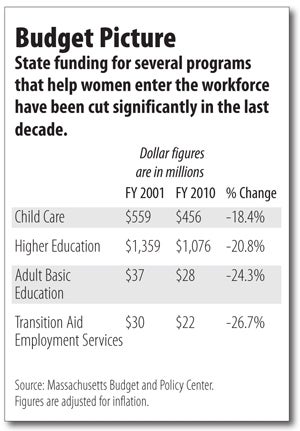The Glass Floor | Report shows budget cuts frustrate women's work force entry

A couple of recent studies have pointed to women’s growing role in the work force: women are on the verge of making up a majority of U.S. workers, while one in five married women earn more than their husbands, up from one in 25 in 1970.
But a new report from the Massachusetts Budget and Policy Center paints a different picture. It shows that some recent cuts to the state’s budget are limiting some of the services that are most crucial for women who want to work.
Titled “An Unstable Ladder,” the report focuses on child care subsidies, programs to help welfare recipients find jobs and public colleges and adult education courses.
Ivette Olmeda, program manager for the Center for Women & Enterprise’s Worcester office, said her group is among those that has lost state funding, though it still receives federal funds. “I think cutting funds eliminates opportunity,” she said. “I think we’re facing a big problem.”
She said budget cuts make it difficult to offer affordable classes for everyone who wants them, especially as more women who’ve been laid off have sought out CWE for guidance in starting small businesses to support themselves.
Missed Opportunities
According to the report, in an average month in 2009, Massachusetts families received subsidies to help provide child care for 57,000 children. Funding for the subsidies has been cut several times over the past year, leaving more families on a waiting list for the support.
Mary Roth, who runs the Hope for Women job training programs at the House of Peace and Education in Gardner, said the difficulty in getting help with child care can keep women from taking courses or starting a job.
“Sometimes that completely derails their attempts to go back to work,” she said. “Timing may be an issue.”
Higher education and adult ed may be less obviously a “women’s issue,” but the report notes that more than 60 percent of enrollees in both public colleges and adult basic education classes are women. And, it says, women actually benefit more from a higher education than do men. For example, Massachusetts women with a bachelor’s degree earn 69 percent more than those with a high school education, compared with a 60 percent differential for men.
Budget cuts have reduced the slots in adult basic education classes by about 2,000, according to the report.
It says public colleges and universities have so far been able to get federal recovery funding to substitute for the loss of state funds, but it’s not clear whether that will continue going forward.
Gail Carberry, President of Quinsigamond Community College in Worcester, said that, even with extra federal funds coming in, the college has already had to work hard to balance its budget, especially since enrollment has skyrocketed over the past three years.
Carberry said about 60 percent of QCC’s students are women. She said education for women is a key goal for community colleges both because women often struggle to improve their earning power while taking care of a family and because one of the strongest indicators of child’s likelihood of academic success is their mother’s education level.
“It’s a really profound social issue that has strong economic implications for the long term,” Carberry said.
Funding for employment support for people in the Transitional Aid to Families with Dependent Children program dropped from $35 million in fiscal 2008 to $22 million in fiscal 2010 in inflation-adjusted terms, according to the report.
The programs offer TAFDC recipients, the vast majority of whom are women, help with job training, job searches and things like transportation to and from work.
Roth said the situation can be very difficult for the recipients, who are generally required to work or train for work but may not be able to do so without some type of support.
Some lose their benefits entirely without finding a job, she said. Others use a program option that allows them to do community service instead of paid work, but that leaves little time for any kind of job search.
“You can do the community service hours, but it takes away from what you might be able to do that might advance you,” Roth said.









0 Comments